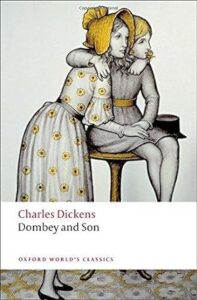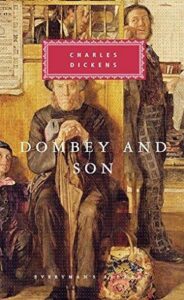Whenever I return to Dickens, I wonder why I don’t reread him more often. All that glittering irony, rich characterisation and accurate observation as if he were sitting with a sketchbook. Yes, he probably is the greatest novelist in English and Dombey and Son (1848) is one of his best.
It’s the story of a London based shipping magnate whose whole life is focused on his thriving business and the acquisition of a son to work with and ensure the future. There is a son but he’s tubercular like his mother, who dies giving birth to him. An older child, Florence, who becomes effectively the novel’s central character, is ignored and despised for being both alive and female. Of course – and I don’t intend to give away too much plot here – Mr Dombey is eventually punished for his unthinking cruelty and then redeemed so that, after 900 or so pages, we get a satisfying happy ending. Like most of Dickens’s novels, Dombey and Son comes with moral underpinning.

When Philip Larkin produced the unforgettable line “They fuck you up, your mum and dad” in his profoundly pessimistic, 1971 poem This Be The Verse, he was writing nearly 130 years after Dombey and Son, but Dickens is making the same point. Parenting is a major theme. In addition to the dysfunctional Dombey family we get flawed Edith and her appalling “mutton dressed as lamb” mother, along with grasping Mrs Brown and her chilly daughter Alice who comes with a history which is, for a long time, mysterious. In contrast Dickens gives us the delightfully happy Toodles family, producing and nurturing lots of children, and Sol Gills, uncle to Walter who acts as a very loving father to his nephew. And when Florence meets Edith they bond immediately as mother and daughter although it does not end happily. By the end of the novel Florence has a child of her own who, of course, is getting all the affection he deserves. The happy parents and children highlight the unhappy ones.
James Carker, who is Mr Dombey’s right hand man in the office, is the villain of the piece. And we know that he’s up to no good from the moment he appears. His teeth are the giveaway. They are large, white, gleaming and predatory. And for hundreds of pages Dickens never mentions Mr Carker without a reference to his teeth – it’s witty in a sinister sort of way and clearly signals that a man with such teeth is not to be trusted. That’s why reading a book is always better than any TV version such as the BBC 1983 Dombey and Son. Irony disappears in adaptation and you lose elements like those evocative teeth.

It is often said that Dickens was no good at virtuous women. And it is true that Florence (like Agnes in David Copperfield, Rose Maylie in Oliver Twist and Harriet Carker in Dombey and Son) is a bit saccharine, although considering how badly she is treated by her father, we sympathise with her in horror. I’m not sure, though that it’s plausible, for someone so starved of paternal affection throughout her childhood to go on loving him unconditionally. She’s sad and puzzled – but never critical which somehow makes her too saintly to be believed. No teenage hormones in 1848?
What Dickens is utterly brilliant at are the individualists. Susan Nipper, Florence’s devoted maid and friend, is a gorgeous creation. She has flashing dark eyes, a forthright manner, will not suffer fools and would do anything for Florence. When something finally flips and she beards Mr Dombey in his study and forcibly tells him what she thinks of him, you want to cheer her on.
Captain Cuttle, is eccentric and sometimes misguided, but he’s very decent and most of us would be honoured to have him in our lives. And we’ve all met people like the irritating, pompous Major Bagstock, when we couldn’t find a way of avoiding them.
Dombey and Son is set in the 1840s as the railway lines north of Kings Cross were being developed. The detailed, graphic, colourful description of Camden Town under very disruptive reconstruction would have been very current in 1848 when the novel was published. Mr Toodles, who lives nearby, works on the building site and later becomes a soi-disant well-paid engine driver. It really conveys what an era of dramatic change this was when suddenly you could get from London to Birmingham in a couple of hours. Nothing equalled it until the commercial airlines were developed nearly a century later. In some ways railways are thematic in Dombey and Son. No prizes for guessing how a certain toothy gentleman gets his comeuppance.

As so often in a Dickens novel there is also an education theme although this time it doesn’t relate to cruelty and abuse. Doctor Blimber’s school in Brighton, where the ailing Paul Dombey is sent to board aged 6, is all about being crammed with the classics. The boys (including Toots – another quirky, loveable but troubled character who lasts the whole novel) are well fed, treated kindly and live quite comfortably but Dr Blimber, his daughter and the gloriously named Mr Feeder force feed Latin and Greek relentlessly. Dickens, of course, is jokily sceptical about the wisdom and usefulness of all this. Florence, meanwhile, is lodged with another whacky, self-interested character called Mrs Pipchin round the corner so that she can visit her beloved, but delicate, little brother at weekends.
As an artistic trait, the Dickensian coincidence is up there with the Rossini crescendo or the Reubens fleshy female. So of course there are lots of them in Dombey and Son when all those minor characters and subplots turn out to be linked and he ties up all the loose ends with a flourish and maybe a tear.
In short I loved it to bits and admired it – again. And I think this is the third time, or maybe the fourth, that I’ve read it. It improves with age like good claret. Warmly recommended.
Next week on Susan’s Bookshelves: Fyneshade by Kate Griffin.